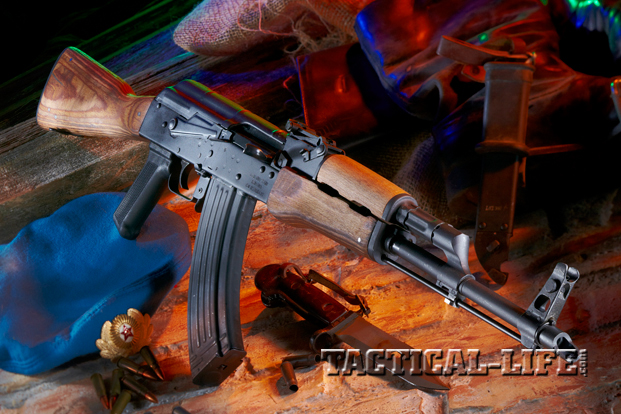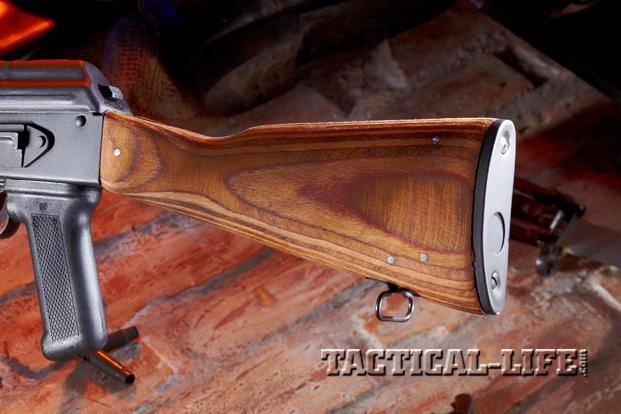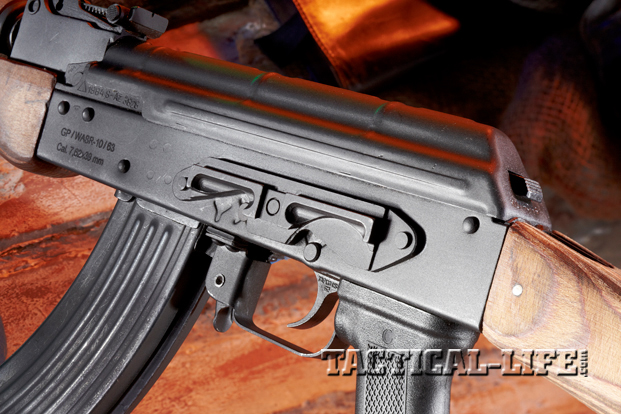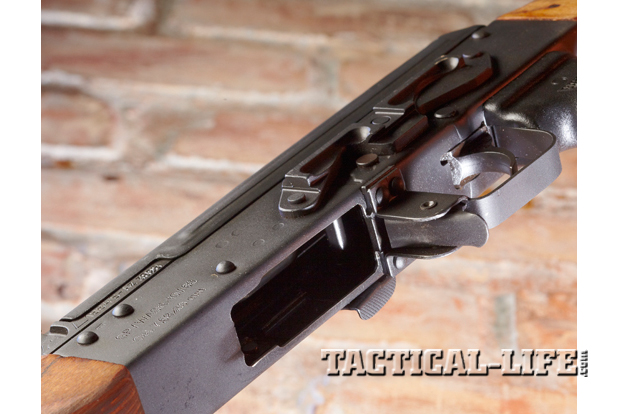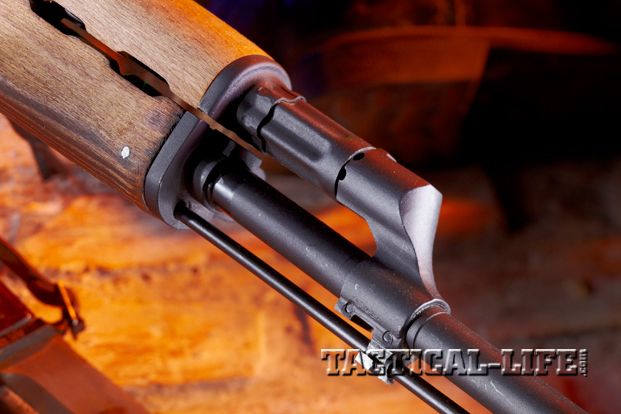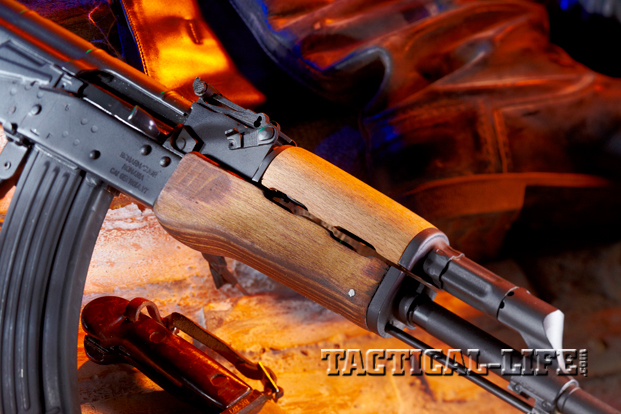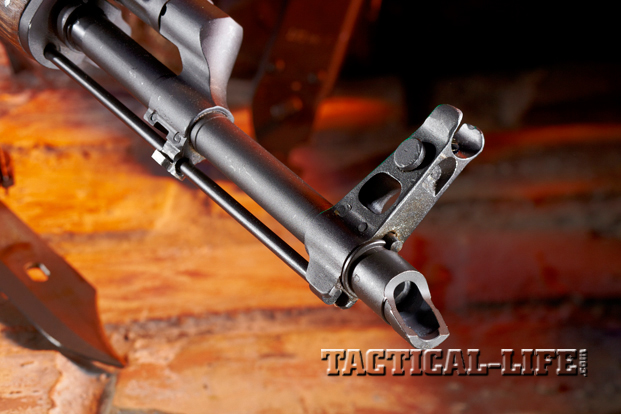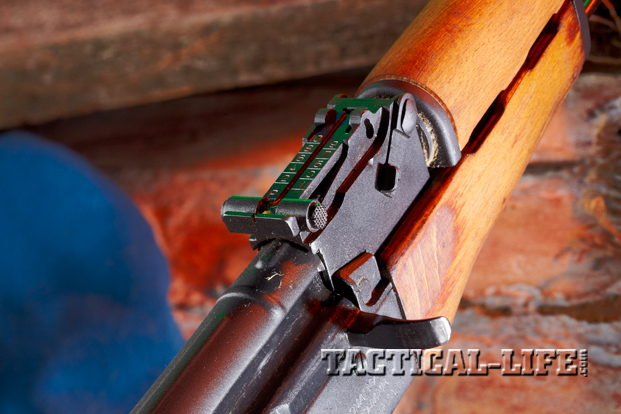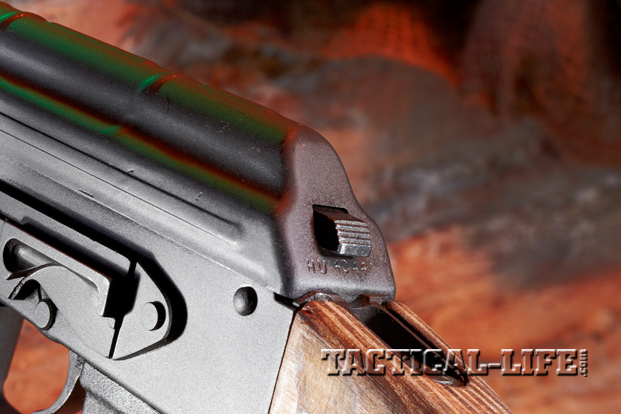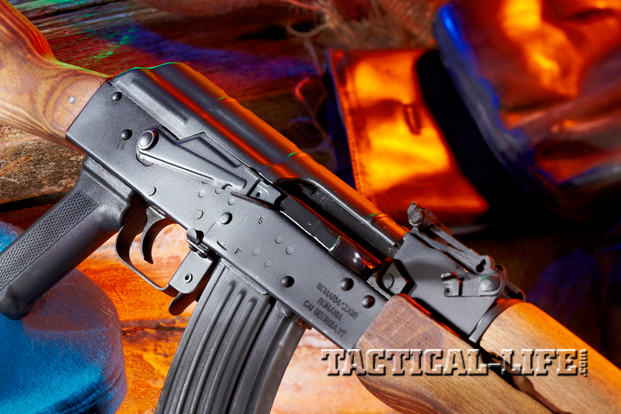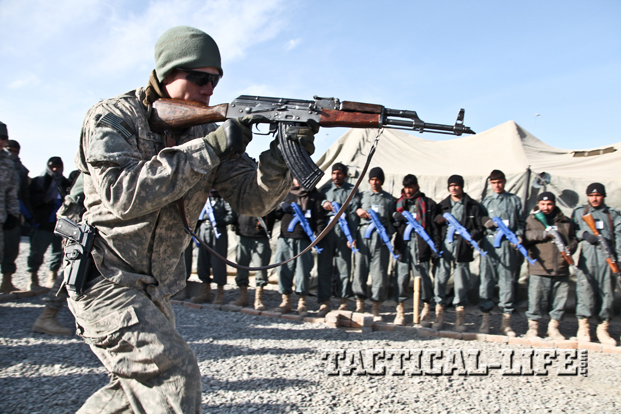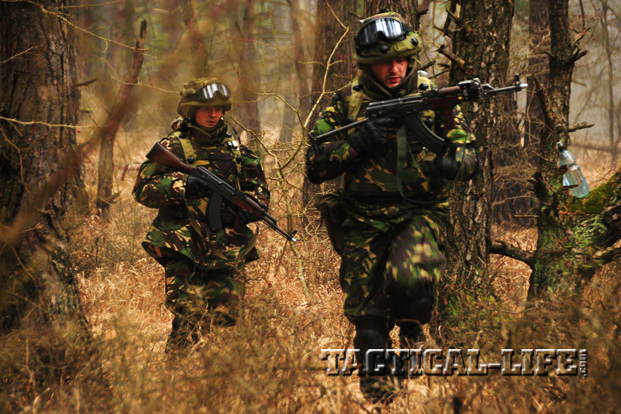Thanks to the efforts of Century International Arms, you can own a semi-automatic, Romanian–U.S. hybrid of this classic small arm in the GP WASR-10.
For the West, the AR-15/M16 is the iconic military weapon of the modern world. Yes, the Heckler & Koch G3 and the Fabrique Nationale FAL are icons in their own right, and more radical offerings like the Austrian AUG and the French FAMAS have earned their recognition, but Eugene Stoner’s classic AR is clearly the West’s dominant design. But what about a non-Western exemplar for the 20th century and beyond? Well, that is the Soviet Union’s Avtomat Kalashnikova—the AK.
Generated from the intellect of Mikhail Kalashnikov, the select-fire AK represented the post–World War II movement toward what has become known as the “assault rifle.” It started in the latter years of WWII, with the German StG 44 and its innovative 7.92x33mm cartridge. The term “assault rifle” (putting aside the overheated rhetoric and misapplication of this moniker in today’s political realm) came to describe weapons that had the submachine gun’s high-rate of full-automatic fire and magazine capacity as well as the traditional rifle’s longer range and power.
Advertisement — Continue Reading Below
The reasoning behind this new approach to weapon design was derived from the hard-earned knowledge gained through extensive urban combat in Europe during WWII. In many cases, engagements occurred within 200 yards and a superior rate of fire often decided the contests. A rifle that could fire in bursts and be optimally effective out to a few hundred yards seemed to offer the best of both worlds. Kalashnikov no doubt recognized this fact through firsthand experience: He was a tanker in WWII, who proved to have a knack for engineering (and re-engineering) military equipment. Shortly after the war, he set about developing what would become one of the world’s most influential weapon designs. The culmination of a host of early prototypes that Kalashnikov developed, enhanced and refined, the first AK-47 appeared in the late 1940s and quickly became the dominant weapon design for the Soviets. At its core, the AK was (and is) utterly simple—both in operation and manufacturing. Operationally the heart of the design is the AK’s “long-stroke” gas-piston system. A gas port in the barrel, located at the 45-degree-angled gas block roughly 2 inches forward of the handguard, taps gas off the bore when a cartridge is fired. This gas impacts against the forward face of a large gas piston, which is affixed directly to the bolt carrier assembly. As a result, the force of the gas pushes back this large, heavy chunk of steel to rotate and unlock the dual-lugged bolt from its locking recesses to cycle the action. Although a long-stroke piston system may not be the most conducive to precision accuracy, it does lend itself to remarkable reliability due to the heavy mass of steel cycling the action (and also to vigorously ejected fired cases).
Compared with the AR and its numerous buttons and extensions, the AK takes a much more simplified approach. Its external controls are few in number and easy to operate. The charging handle (exposed through the ejection port) is used to manually cycle the action and can also act as a “forward assist.” The large safety lever/dustcover is located behind the ejection port and is pushed up for “safe” and down for “fire.” The magazine release, located forward of the triggerguard, is a paddle style that is pushed forward to allow the magazine to be rocked forward and out.
Simplicity was a core theme of the AK’s manufacturing. Initially, the AK was to be built on a stamped sheet-steel receiver due to the reduced cost and light weight of the medium. However, early production variants had a tendency to warp under extreme heat, so a milled steel receiver (which was heavier and more material intensive to manufacture) eventually became the standard for early-era production AK-47 rifles. The AK’s 7.62x39mm cartridge is also worthy of note. Similar in spirit to the German 7.92x33mm cartridge, the 7.62x39mm (which would be first chambered in the Samozaryadnyi Karabin Sistemi, or SKS) differed from the earlier Soviet 7.62x54R cartridge in that it was rimless and significantly shorter in length. The result was a cartridge that could be fielded in a smaller and lighter firearm and would have the potential to excel in a select-fire weapon. Once the cartridge found a home in the AK-47, there was no looking back.
Second Time’s The Charm
Although the AK-47 was an immediate hit and an ideal weapon design for the Soviets, there was an underlying desire to further refine some of the weapon’s elements and features and to get back to a stamped-steel receiver. Once issues concerning Soviet sheet-steel production and manufacturing had been addressed, the AK went back to the drawing board.
The result was the Avtomat Kalashnikova Modernizirovanniy, or AKM. Appearing around 1960, it was a modernized variant of the AK that took advantage of new developments in the Soviets’ sheet-metal manufacturing procedures, which cut down on weight and (ultimately) production costs and time. To accommodate this thinner, lighter material, the receiver featured a stressed-steel trunnion located in the forward portion of the receiver. (A rear steel stock attachment trunnion was located in the rear section of the receiver.) The forward trunnion housed the recesses into which the bolt’s twin lugs rotated and locked. Also, the AKM included a top cover stamped from thinner metal but featuring reinforcing ribs to maintain strength and rigidity. The AK’s original wooden stock system was replaced with one made of laminated wood, which offered greater resistance to the elements (and was later changed to synthetic materials). The AKM’s muzzle was threaded to accept attachments, with one of the most common being a “slant brake” with a 45-degree angle to help offset recoil under full-automatic fire. An interesting characteristic of the brake is its rightward (clockwise) rotation, which helps offset recoil for right-handed shooters.
The resulting AKM became the most commonly encountered and recognizable variant of the AK platform, one produced in the tens of millions throughout the world. If you were to watch the news today, you would likely see, in hot spots around the world, numerous examples and variations of the humble AKM—often fighting on both sides of the conflict!
Stateside Rendition
Fortunately for today’s firearms enthusiast here in the U.S., one does not have to emigrate to a former state of the Soviet Union and join its military to get a chance to try out one of these rifles. Thanks to the efforts of Century Arms, you can acquire your own semi-automatic-only variant of the AKM right now. The GP WASR-10 is the result of a collaboration between Century and famed Romanian arms-maker Cugir. With a history dating back more than two centuries, Cugir has produced numerous variants of the basic AK platform for not only domestic use but also export. Due to the nature of current U.S. firearms laws, the guns are imported as single-column-magazine semi-automatic rifles. Once they arrive, the requisite number of U.S.-made parts are added and the magazine wells are adapted to accept double-column magazines.
Advertisement — Continue Reading Below
According to Century, the WASR is generally based on the Romanian Model 63 and GP 75 AKM rifles. The resulting rifle is a reasonably close semi-automatic approximation of an AKM, with a few differences. First and foremost is a notable visual cue–namely the lack of “dimples” on either side of the receiver above the magazine well. Apart from the semi-automatic operation and two-position safety (rather than the true AKM’s three-position safety with a full-auto setting), the GP WASR-10’s only other significant tell is the lack of the AKM-style “bulges” on the lower handguard. The rest of the rifle—from the laminated buttstock, to the stamped sheet-steel receiver and top cover, to the end of the slant brake that tops off the 16.25-inch, chrome-lined barrel—is based on the original AKM design. The WASR also features a handy optic-mounting rail on the left side of the receiver.
Gun Details
For the purpose of this review, I requested a test sample of Century’s GP WASR-10. It was exactly what I expected: a little rough around the edges but, for AK enthusiasts like myself, a pleasure to handle and examine. The WASR’s finish is a black phosphate on all the exterior metal, and the laminated stock set and wooden upper handguard had an attractive matte finish on their exteriors. (I will note that the gun had fewer tool marks and a smoother finish than I have seen on earlier examples of this type of rifle.) The GP WASR-10 came with two 30-round magazines. As I tried to insert one, I had some difficulty but was able to seat it. I tried the other and came to a total standstill—I simply could not get it to seat. I retrieved my calipers, measured the width of the two magazines at their mouths and found that they had roughly 0.005 to 0.007 inches of variance between them. I then measured the magazine well and found that it was roughly 0.005 inches smaller than the larger of the two magazines. Armed with a mill bastard file, I broke down the rifle and set to opening up the magazine well. Going slowly and checking magazine fit regularly, I soon had the smaller of the two magazines seating cleanly and easily. With a little more work (now going very slowly and checking regularly), I had the larger of the two magazines seating cleanly (but still slightly snug). Once all was said and done, I had opened up the length of the magazine well sides roughly 0.007 inches.
As the rifle also came with a bayonet, I decided to give it a try and discovered that it required some taps with a hammer to fully seat. I could see the high points where the bayonet’s rear interface point had worn on the bayonet lug, so I started to give those areas some light sweeps with the file. About 0.006 inches later, I had the bayonet fitting easily. I then cleaned up the lug and the magazine well with some sandpaper. After removing all the metal shavings, cleaning out the rifle, reassembling it and lubricating it, I headed out to the range with a selection of American Eagle and Remington 7.62x39mm ammunition. Although the rifle did feature a side-mount scope rail, I decided to test it with the standard iron sights (made up of a sliding tangent rear notch and a winged post front sight that is adjustable for windage and elevation).
Advertisement — Continue Reading Below
Range Time
I set up a target at 100 yards and settled in at the bench with the GP WASR-10 loaded with a 30-round magazine. To see what type of accuracy the rifle was capable of, I ran three five-shot groups with both types of ammunition. The trigger was very light with a 4-pound pull but did not have a clear break. However, once I settled in with the gun, I was able to get some good results. With the American Eagle, I averaged just under 4 inches at 100 yards, with a smallest group of 3.1 inches. The rifle showed a distinct preference for the Remington load I tried, with average groups at a tight 2.2 inches and a smallest group measuring an astonishing 1.65 inches at 100 yards. I then refilled the 30-round magazine and started running the rifle for function testing. After firing several magazines, on top of the velocity and accuracy testing, I put a few hundred rounds through the rifle. There was not a single malfunction during the entire test. Recoil was notable but still manageable.
The AKM is clearly one of the most dominant weapon designs today. Through its long history as the vanguard of the Soviet small-arms industry to its role in numerous Cold War–era proxy wars and local conflicts, from the collapse of the Soviet Union to the present day, the Avtomat Kalashnikova has proven more enduring than the revolutionary ideological movement that spawned it. And, thanks to Century, you can own your own version of this classic firearm, the GP WASR-10. For more information, visit centuryarms.com or call 800-527-1252. To learn more about the history of this storied weapon, read Edward Clinton Ezell’s Kalashnikov: The Arms and the Man, which is available at collectorgrade.com. ★
